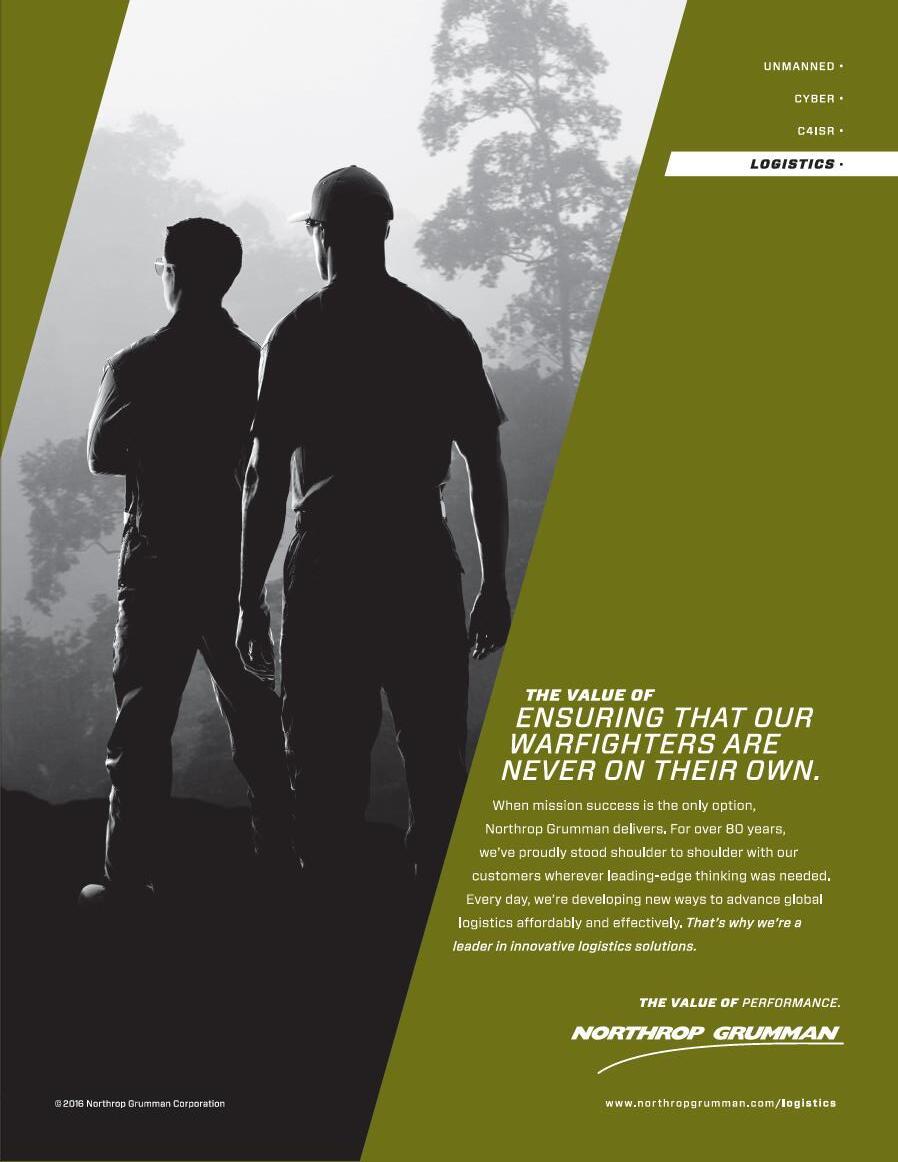
























 Dennis P. Dabney President, LOA
Dennis P. Dabney President, LOA

Esteemed Members,
I hope this message finds you well and enjoying the beginning of summer. Your Logistics Officer Association National Board is hard at work taking care of administrative items, firming up the National Symposium agenda, assisting the Acquisition Officer Association (AOA) standup and establishing strategic partnerships.
First off, please join me in welcoming Jeff Decker as the newly appointed LOA Historian. Jeff is a graduated group commander, former Advanced Maintenance and Munitions Officer School (AMMOS) Commandant and renowned military historian. His passion for fusing military history and leadership lessons is evident in daily “Stand To” e-mail messages he sends to members of his unit and a long and distinguished list of loyal followers. You will begin to see Jeff’s thoughtful work in the LOA Historian Monthly Perspective coming soon. The National Board revised the LOA Strategic Plan, LOA Guidance and by-laws during an off-site earlier this year. The revisions were necessary to reflect changes to the Association membership, improve the chapter award program and association processes. For example, newly published LOA
Guidance now includes rules of engagement for academia requesting access to our membership for research purposes. The by-laws will be sent out for member vote this month and the LOA Strategic Plan will follow.
The 2016 Logistics Symposium and University is scheduled for 11-14 October, 2016 at the Gaylord National Resort and Conference Center in National Harbor, Maryland and we are excited about the variety of panels and sessions for this year’s LOA L.I.V.E event. In addition to LOA University and popular agenda content, we responded to Chapter feedback and now include new topics such as anti-access/area-denial (A2AD) strategy, joint spouse issues, leading in a crisis, Senior Women in Defense Panel, and innovation. Please follow LOA social media for updates or go to atloa.org and click the Symposium link for details. Registration will open soon.
The AOA chapters are growing in numbers across the nation and the Washington DC chapter hosted a kick-off event featuring senior acquisition leaders and LOA National Board representatives. Charter members Lee Olyniec, Rich Hanberg and Shawna Matthys are doing a great job spreading the word. The Association is excited about our growth in this area and grateful for the opportunity to share the professional development model and forums that have benefited the maintenance and logistics corps for over 30 years.
For well over a year now, LOA has partnered with institutions and organizations to facilitate association marketing and development/training opportunities to members. The Association renewed a mutual marketing and support partnership with Aviation Week recently and finalized a partnership with The Institute for Defense and Business (IDB). IDB has been a loyal contributor to LOA and recently added veteran transition services to its suite of services available to LOA members. We look forward to continued success with these organizations.
In closing, I continue to be very proud of the professional development at the chapter level. I am also grateful for the engagement between our senior leader/mentors and the acquisition and logistics membership. Thank you very much for your time, advocacy and all that you do to promote the Logistics Officer Association.
Looking Forward,
Dennis P. Dabney President Logistics Officer Association253-732-4060
president@loanational.org
www.atloa.org


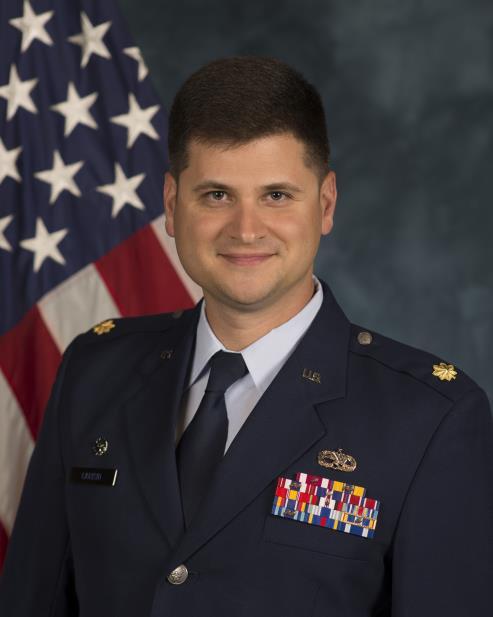
Readers,
With excitement and anticipation, I have happily received the editorial reins from Lt Col Jim Dorn, to whom I am indebted. He has served this journal in various capacities throughout the last ten years, maintaining the rigorous standards that have characterized this publication for over three decades. Lt Col Dorn continues his active service as the Commander of the 92d Aircraft Maintenance Squadron, ensuring as ever that the Fairchild flightline remains safe, reliable, and efficient.
The rest of the journal staff remains unchanged, and has yet again furnished excellent work for the current issue. You will see incremental changes to format and layout over the next few installments, as we incorporate some aesthetics of print journalism into this digital medium. The standards for content, however, will remain unaltered. This journal will persist in publishing articles to inspire, inform, challenge, and develop Air Force logistics leaders.
Your feedback and recommendations remain vital to that mission, and I encourage you to assist through your suggestions in tailoring the Exceptional Release to better serve this Association. I am very fortunate to serve in this cause, and must extend my thanks to the

Executive Board for their selection and confidence. As Col Dabney quipped in our previous issue, “I can’t make this stuff up.”
Another logistics exemplar, Lt Gen Leo Marquez, admonished us several years ago: “If our aircraft, missiles, and weapons are the teeth of our military might, then logistics is the muscle, tendons and sinews that make the teeth bite down and hold on logistics is the jawbone!” This publication gives voice to the maw of combat airpower, articulating messages from the quiet professionals who perpetually maintain it.
Labor omnia vincit, Gerard J. Carisio
Greetings Log Nation! We continue to be the world’s premier fighting force in air, space and cyberspace because of your commitment to service, continuous adaptability and innovative spirit. Even more remarkable is that we are succeeding amid an ever-changing political and technological landscape.



In my last article, I introduced a set of LOGTRUTHS or “loggiemantras” that I believe are the most important logistics lessons Airmen have learned in over 70 years of American airpower. In the face of change and uncertainty, these
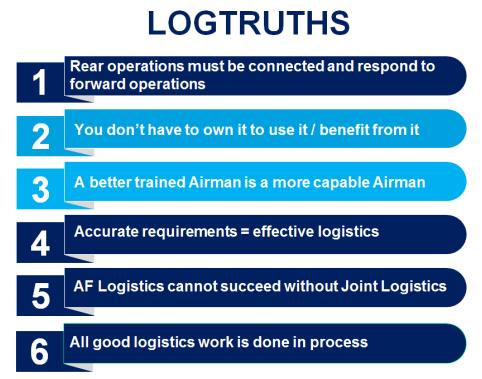
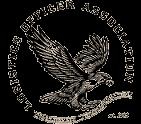



LOGTRUTHS have proven to endure the test of time.
In this issue, I want to discuss LOGTRUTH2: “You don’t have to own it to use it or benefit from it” and LOGTRUTH3: “A better trained Airman is a more capable Airman”.
LOGTRUTH2: You don’t have to own it to use it/benefit from it
We recently marked the 25th anniversary of Operation DESERT STORM/DESERT SHIELD. During this campaign, we spent months planning and amassing forces and supplies to counter the Iraqi government’s aggression, and we brought everything we needed to be self-sufficient. Flash forward to Operation ENDURING FREEDOM (OEF) some 10 years later. In the early stages of the campaign, we relied on building up air bases like Bagram and Kandahar, but quickly learned the geography in the region made our build up more difficult. We also started to see a shift take place during the final years of OEF where we relied more on our partners for access (in air and on land) and support (airspace, bases, airfields, contractor support, etc.).
In a rapidly-changing global environment, our adversaries will attempt to deny our ability to operate using older paradigms. Our thinking must shift to “places” instead of “bases”. We will need to rely less on massive pre-positioned assets and find better ways to utilize existing resources. It may include working together with partner nations where they fund construction on their bases for our collective use, or piggy-backing on processes and relationships utilized by NGOs or local contract capabilities to a greater extent. The good news is we don’t have to look far to see LOGTRUTH2 in action today. Our Civil Reserve Air Fleet, Air Force Reserve Component, and our strong international partnerships are examples of how we utilize aircraft, bases, materiel and personnel that we do not organically own.
Comprised of commercially contracted aircraft, the Civil Reserve Air Fleet provides inter-theater airlift in support of our operations.

Provide a highly-skilled Reserve force that supports all roles and functions across the Air Force, like maintenance on our aircraft.
rotation of theater security forces in support of Operation ATLANTIC RESOLVE.

In each of these examples, we meet our operational requirements by “owning” less and “pooling” more. This truth doesn’t only apply to external partners; we also put LOGTRUTH2 into action under our own roof in the WRM centralization effort. Last April, the WRM Global Management Office declared FOC and has already delivered tangible results like reducing the Equipment/MRSP Initial Stock Fund disconnect by 57% (from $189.3M to $81M) through records corrections and reallocation of mal-distributed stock. IT systems are another area we should capitalize on. There are numerous Joint and commercial applications we can (and will!) utilize to modernize our information systems over the coming years.
Of course, there are situations that require us to have ownership and we must carefully assess the appropriateness of each. However, if we continue to establish and maintain strong partnerships within our own Air Force community, with our sister Services, Allied and industry

partners, we can hold our advantage and maintain our unparalleled strength as the best Air Force in the world.
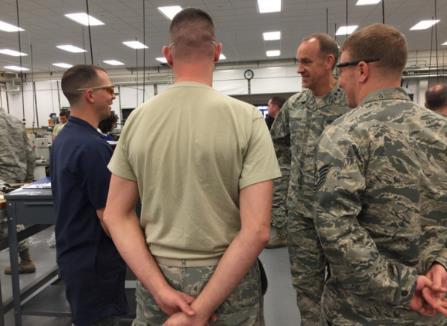
Our Air Force is powered by highly capable Airmen who are focused on missions across the globe. As leaders, it is our job to train and equip our Airmen to be elite performers. What does it mean to be an elite performer? It means our Airmen have the right knowledge, experience, tools, technology, and confidence to be successful regardless of the operational requirement.
While LOGTRUTH3 (A better trained Airman is a more capable Airman) may seem obvious, our actions today do not always support what we know to be true.
Has your unit ever left a training slot open (or pulled someone out of class at the last minute) because of the flying schedule, summer leave, or another priority? The impact of having a trained and capable Airman versus one who is not trained is very simple – we win or we lose. We must change our mindset about training because we owe it to our Airmen to give training the time, attention, and priority it deserves.
In February, our senior “loggies” convened at Sheppard Air Force Base, Texas to talk solely about how we train, equip, and prepare future logisticians for missions 10, 20 and 30 years from now. From that meeting, we developed a Logistics Human Capital strategic framework that focuses on the competencies our Airmen will need. The strategy
also helps us identify and create the education, training, and experience required to build the competencies our Airmen need over the course of their careers.
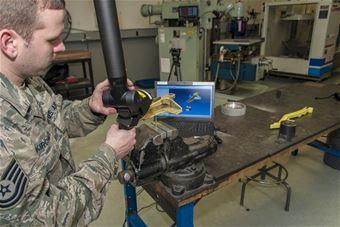
I am excited about the great work we are already doing in this area. For example, we are working to operationalize a Strategic Logistics School (SLS) that will challenge maintenance, munitions, and logistics readiness officers to think creatively in new and unchartered environments, as well as research emerging concepts. These efforts will lead to tangible, lasting results in the form of doctrine that can be codified and woven into our Log Nation culture.
In our business, speed and innovation wins. How can we learn and think faster and further than our adversaries in the future? One way is to train differently. The Deliberate Continuum of Learning (DCoL), built by AFIT's School of Systems and Logistics, is a suite of easily accessible short courses targeting Field Grade Officer (FGO) logistics competencies. These courses will provide gap-filling training and knowledge enhancement to better prepare our FGOs for joint tours or select staff-level, depot, or sustainment positions. Both SLS and DCoL highlight that learning doesn’t have to be in a traditional classroom with an instructor. Rather our learning and training environments should mirror and support how we perform our jobs in the fight. We have to build a culture of continuous learning for logisticians to get the right skills at the right time.
During last year’s LOA symposium, I talked about autonomous equipment and other technologies that appear to be light years away but are actually available today. Technology that enables Airmen to be even more capable is a game changer. Applications like 3D printing, direct digital manufacturing, and wearable augmented reality “Smart Glasses” are at our fingertips today. Our challenge is to find ways to use these technologies on the job, in training environments and seamlessly incorporate them into how our Airmen learn and work. Finding the right technology will empower our Airmen to become smarter and more capable.
As we transition to a more technologically advanced Air Force, it will require organizational flexibility and adaptability to accomplish LOGTRUTHS 2 and 3. We should continue developing strong partnerships with our sister Services, Allied and industry partners around the globe to have greater access to assets and capabilities outside the Air Force. We must also make advancements in the way we train our Airmen, find ways to utilize newer technologies, and teach them to become more adaptive learners.
In the next ER article, I’ll discuss LOGTRUTH4 “Accurate requirements = effective logistics” and LOGTRUTH5 “AF logistics cannot succeed without Joint logistics”. As always, I want to hear your thoughts on these LOGTRUTHS. I encourage you to discuss them with your local LOA chapters and don’t hesitate to send me your inputs via Twitter @AFCoopA4.
Thanks for all you do every day for Air Force Logistics!
Lt Gen John B. Cooper, Deputy Chief of Staff for Logistics, Engineering, and Force Protection Headquarters U.S. Air Force, Washington, D.C.Dear Loggie nation,
Thank you for the great honor of serving as your Director of Logistics for the last two years! I’ve had the opportunity to meet many phenomenal logisticians during my tenure and I am continually impressed by all you do for our Air Force. YOU, our people are truly our most important resource and logisticians, in particular, are the backbone of our Air Force mission.
It is with the importance of our community and our future in mind that Log Board which is made up of logistics leaders across the Air Force, recently approved and published the first-ever Logistics Human Capital Strategy (LHCS). The LHCS is an annex to our Enterprise Logistics

Flight Plan (ELFP)*and it provides the foundation and process for developing the future Air Force Logistician of 2035. I want you to be as excited about this future as I am, so I’m sharing a vignette from the LHCS that I hope will encourage enthusiasm and optimism about our future! You can also find the LHCS in its entirety at:
https://cs1.eis.af.mil/sites/elg/ELFP%20Page%20Drafts/ELFP.aspx





Make no mistake; our future presents us with significant challenges! We believe the future will be characterized by a contested environment both in the cyber and kinetic realms, increased demand for logistics, constrained resources and an imperative for greater Agility. These concepts are outlined in the Air Force Future Operating Concept and the Strategic Master Plan, and I encourage you to read them both if you haven’t already. Building our future force will require critical thinking and hard work. We must do more to define, deliberately develop, manage, retain and enable our logistics work force.
With this context in mind, I hope you will enjoy the logistics vignette that follows, but as you read, it’s important that you focus on the capabilities described, not the specific technology or flightline functional tasks. The purpose of the vignette is to imagine a future that highlights Air Force Logistics operations in an expeditionary environment. It’s not intended to exclude logistics functions, nor is it meant to imply the relative importance or elimination of any logistics

functions. The ideas and capabilities are the important take-aways. Please use your imagination to broaden the scope of applicability across the logistics enterprise, because I want your help!
Your ideas are welcome and encouraged. You may reach out the Air Force Logistics Strategy Division by email at usaf.pentagon.af-a4.mbx.a4-elg-workflow@mail.mil and they will channel your input to myself and we’ll get it to the right POC.
Finally, I want you all to know that your Air Force Logistics leadership is working aggressively to identify and pilot logistics technology. Technology that will “Enable (read the LHCS to better understand my use of the term ‘Enable’)” our Airmen and move Air Force Logistics toward the future, like the one described in the vignette.
Best wishes!
Maj Gen Kathryn “KJ” Johnson Director of Logistics DCS/Logistics, Engineering & Force Protection*Please follow this link to the Air Force Enterprise Logistics Governance site, where you can read the LHCS, ELFP and AF-level strategy documents:
https://cs1.eis.af.mil/sites/elg/ELFP%20Page%20Drafts/ELFP.aspx
On a remote Island in the Pacific, 20 May 2035, 0600L.



Aircraft technician SSgt Harms walked up to her aircraft, one of two F-22s. With her is A1C Johnson, a capable but less experienced technician. SSgt Harms didn't know what was wrong with the jet, but she knew she'd need to have it fixed by 2200L for a 2300L launch. She and Johnson put on their augmented reality safety-interface glasses and were greeted by the Logistics Enterprise Weapons System Cloud Intelligence (LEWSCI), pronounced “Lucy.”
She knows how much she's learned from LEWSCI since technical school, but she also knows that LEWSCI learns from her and every other technician in the Air Force.
SSgt Harms asks LEWSCI, "What do you think is wrong and where should we begin?" LEWSCI summarized the debrief and described the problem. LEWSCI believes the best place to start is the #3 Hydraulic System and asks SSgt Harms her thoughts; they compare experiences and learn from each other. She knows how much she's learned from LEWSCI since technical school, but she also knows that LEWSCI learns from her and every other technician in the Air Force. She's the equivalent of having every expert technician, past and present, over-the-shoulder available for guidance. LEWSCI's not just a partner for technicians on the flightline; she's partnered with civilian and military logisticians across a vast logistics enterprise, from the Program, Manufacturing, and Maintenance Center (PMMC) to the flightline and everywhere in between.
She and Johnson put on their augmented reality safety-interface glasses and were greeted by the Logistics Enterprise Weapons System Cloud Intelligence (LEWSCI), pronounced “Lucy.”
LEWSCI suggests they begin by removing a panel at the horizontal stabilizer for verification that the pressure transducer is functioning properly. LEWSCI can see and hear everything they do because the augmented reality safetyinterface glasses have a camera, screen and mic, which are also connected to an earpiece. After a quick set of preliminary instructions and cautions from LEWSCI, and they're on their way. LEWSCI provides a "WARNING," verbally and via an image projected onto the glasses of the crucial step, which is to ensure hydraulic pressure is relieved before removing the transducer. Upon inspection, Harms and Johnson determine that it is a faulty transducer that has evidence of corrosion.
There's no need to report LEWSCI's idea about the defective filter lot (nor manually document the day's maintenance actions).





[In the supply support lab tent] "Mr. Hurry, can you please assist our maintenance crew with a supply request?" pings LEWSCI. "Of course," replies Mr. Hurry, an expeditionary logistics engineer, making his way to the additive material fabricator in the expeditionary supply support laboratory, "What do we need?" LEWSCI tells him about the transducer and pushes the technical specifications to assist Mr. Hurry in expediting the creation of the part. While waiting for the part to be made, LEWSCI discusses the telltale signs of corrosion they noted during inspection of the transducer. She says this might indicate a water intrusion problem. Johnson and Harms agree. They decide to check the hydraulic fluid filter and indeed there does appear to be a minor defect. A short time later, they've replaced the filter and transducer and complete a preflight. They release the jet to

operations an hour ahead of schedule. The flight lead, Capt Josh Harencak, is always eager to step to the jet a little early!
There's no need to report LEWSCI's idea about the defective filter lot (nor manually document the day's maintenance actions). That was done by LEWSCI as the discovery was being made. LEWSCI has already begun working with the Program Office engineering team on the nature of the problem. By tomorrow, the manufacturer will be apprised of the defect in the filter lot and will adjust the quality control process and have new filters in the supply chain inside a month.
Although LEWSCI still learns as the weapons system presents new failure modes, she has a complete knowledge of the aircraft systems and the unique history of each aircraft and can make technical decisions and predictions at the speed of light.
Like Harms, Johnson was accessioned into the Air Force out of high school. In order to get selected as an aircraft technician, he had to score very high on the New Armed Services Vocational Aptitude Battery, which now includes specific measurements for cognitive ability and adaptiveness, essential to determining his potential to learn a broad mechanical skill set and interface with LEWSCI. Harms was impressed with how well Johnson's year-long technical school had prepared him to perform a range of mechanical and electronic tasks and just as important, how to interface with LEWSCI. Tech school is now completely focused on technical competency. Aircraft touch time is optimized. There's no need to learn about cumbersome, time-consuming manual data entry for a maintenance data collection system. There's no training on filling out aircraft forms or requisitioning parts. Neither are there technical orders to manually reference. "Maintainers do maintenance; not data entry and certainly not paperwork!"


Mr. Fletcher, their Ops Officer, likes to say. LEWSCI does all of this. In fact, LEWSCI was

"there" instructing and interacting with Johnson at tech school (and is there now teaching technicians, including what she learned with her human partners today). Although LEWSCI still learns as the weapons system presents new failure modes, she has a complete knowledge of the aircraft systems and the unique history of each aircraft and can make technical decisions and predictions at the speed of light. Well, just three more days on this deployment. Harms was looking forward to her Permanent Change of Station upon return stateside. She has orders to the PMMC to work on the Programmed Depot Maintenance line. This assignment was unheard of in the past, but with her general technical skill-set and partnership with LEWSCI, she will be able to hit the ground running. ---------------------------------------------------------------------------------------------------------------------
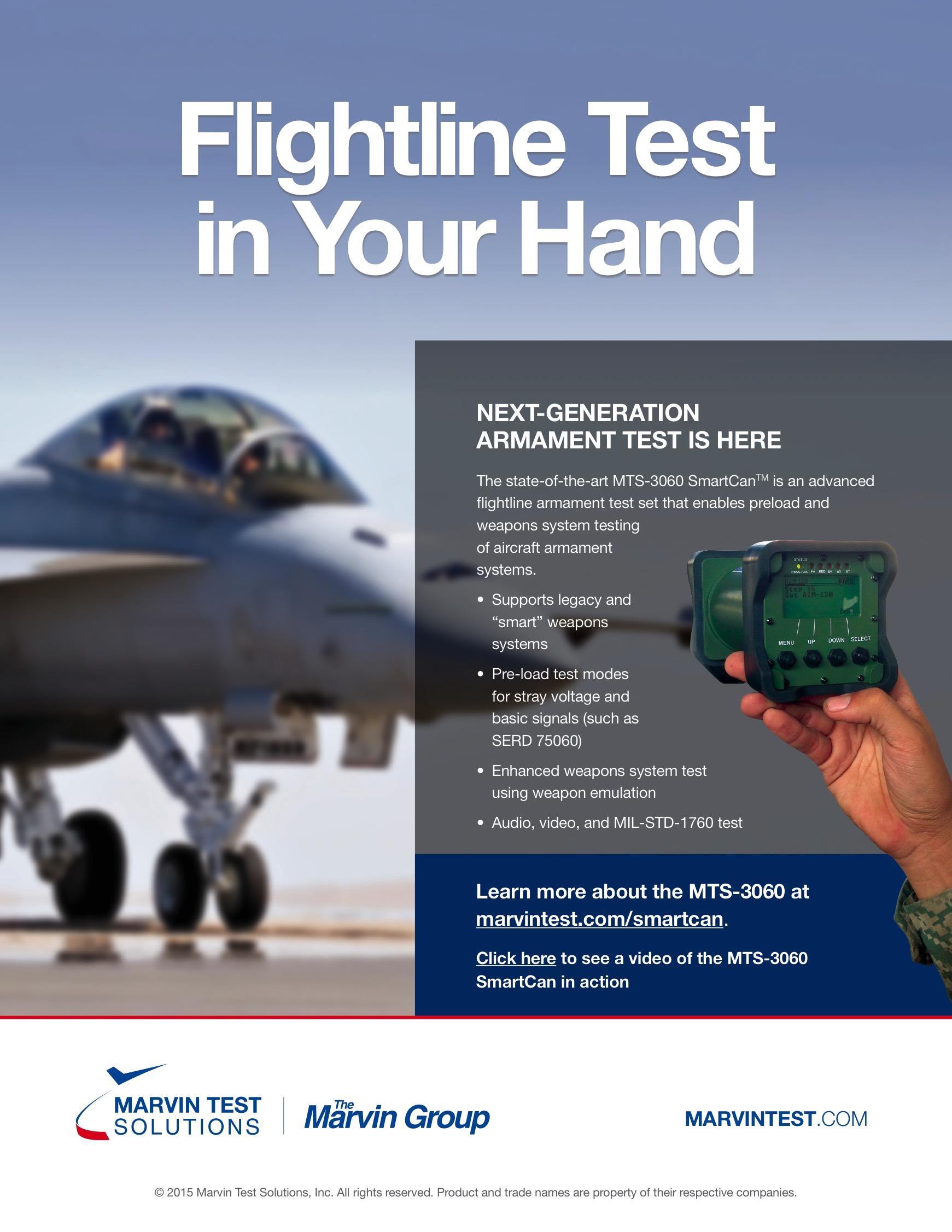
Capt Jessica Schneider, President, Sir Winston Churchill
Chapter – RAF Lakenheath/Mildenhall
LOA Chapter: Sir Winston Churchill
Chapter – RAF Lakenheath/Mildenhall
Position: President
Hometown: Alamo, CA
Family: Husband, Andrew
Education:
University of Arizona, Bachelors History
Embry Riddle Aeronautical University
Masters, Management of Integrated Logistics
Technical Training: LRO School
Professional Duty Title:
Director of Operations, 100th Logistics




Captain Schneider’s first retirement ceremony for “An amazing 2T2”
Readiness Squadron, RAF Mildenhall, UK
ER: What do you like most about being a loggie?
Capt Schneider: There is something different that happens every day to keep you on your toes, especially as a Director of Operations, which can be frustrating but it gives you knowledge and

experience for future situations, as well as stories! Over the years I have heard about amazing logistics jobs all over the world which is very exciting for our young officers to look forward to.
ER: What was your biggest learning moment?
Capt Schneider: During a job transition from one section to another there was an operational issue that occurred over the weekend in the section that I no longer worked in. While I thought it was not my issue because I no longer worked in the section, my boss did not think so. That was the first time I realized that I had a responsibility as a leader to ensure mission success for everyone and every section in the unit not just my area.
ER: What are you most proud of in your time on active duty

Capt Schneider: Being selected for Presidential Support Duty. While it took me out of the 21R career field, it was an amazing opportunity that I would take again in a heartbeat (no one wants to leave!). It was refreshing to learn new skills and work logistics under pressure, as well as meet and work with many people, who I never would have met had the opportunity not presented itself.
ER: As a recognized leader in your local LOA Chapter, what activities/events are you most proud of?
Capt Schneider: Sometimes it is hard to get new and different events together so I am trying to get people information that is useful at every level. Most recently we had presentations on last
fall’s LOA symposium, as well as the AMC Phoenix Mobility program which gave chapter members information on what is new in our career fields, plus possible job opportunities they may not have known before. Sometimes there is not enough communication on opportunities so I would like to offer more of that to our local chapter. We have also set up tours with local logistics companies, Marshall Aerospace and Defense, DHL and Amazon, which I hope opens member’s eyes into logistics operations outside the Air Force and brings back ideas about what we can do better here in the Air Force.




There’s no doubt about it… logistics is a dynamic profession. If one thing remains constant though, it is the need to be flexible and adaptable. This is true at home and abroad. Leave it to the Company Grade Officer (along with many other valued service members) to face that challenge with gusto and get the job done right the first time. It is not always the loggie with the most years in service that is called to the job either. It is time to throw them a bone by putting them in the spotlight. Take for example…Capt Richard W. Hanberg.
Capt Hanberg is from Dothan, AL, and graduated from Auburn University with a Bachelor’s of Science degree in Aerospace Engineering and commissioned through the Air Force Reserve Officer Training Corps. He also holds a Master’s in Business Administration from New Mexico State University. He began his journey in the Air Force at the White Sands


Missile Range, NM as a Test Project Engineer for Detachment 1. He presently serves as Executive Officer to the Commander, 78th Air Base Wing, Robins AFB, GA, where he is married mil-to-mil to Captain Jennifer Lindberg, Aircraft Maintenance Officer, Active Duty Air Force and LOA member, with their newborn daughter Avery.
The ER asked Capt Hanberg to share his thoughts on being a leader…in his own words.
ER: What has been your proudest moment?
Capt Hanberg: Professionally I’m most proud of how quickly the Acquisitions Officer Association (AOA) has established itself and expanded over the past year. What started as a small idea between a handful of officers, much like LOA did when it first started, has quickly grown into a strong and diverse organization. All of the credit goes to the hard work of our junior acquirers, the chapter mentors, and the support our senior leaders. AOA is only as strong as its members. The concept of AOA was sketched out over e-mail. Volunteers took the lead to represent each base, established an interim chapter, and transformed the initial concept into something greater than I had imagined. Since January 2015, AOA has grown to encompass five chapters and over 100 official members. Lastly, a huge amount of our success was due to our partnership with LOA. I look forward to the future as these two organizations continue to grow together.
ER: How do you keep your leadership skills honed?
Capt Hanberg: Study, observe, and practice. I carve out some time to listen to audio books on various subjects: leadership, management, social sciences, critical thinking, and human nature. I strongly recommend expanding beyond the standard leadership focus reading lists. As leaders, understanding organization concepts, human relations dynamics, problem solving, and other concepts applicable to our career field will make us better leaders. While in the office, I ensure I’m observant of the leaders around me. Much can be learned by watching and listening to leaders at all levels; whether they are a SNCO, 2nd Lieutenant, or General Officer. I’ve taken leadership notes from brand new airmen. Finally, I believe that leadership takes practice.
Opportunities to practice don’t have to be the assigned leadership roles attached to a rank/position. I encourage my fellow CGOs to volunteer for opportunities that challenge your current perspective as a leader; e.g., deployments, broadening programs, and unique assignments. If you want to hone your leadership skills, get out of your comfort zone and practice…wherever and whenever possible.
ER: What leadership skills/traits are most important to logistics officers?
Capt Hanberg: In my opinion, what separates great leaders from good leaders is the ability to lead laterally. Leading laterally is being able to affect positive change beyond your assigned unit and help lead your peers. Great leaders lift up their sister organizations and can push their peers to be better leaders/loggies/acquirers. If your unit’s crushing everything in its path, then share those lessons learned with other organizations -- a rising tide lifts all boats.
ER: As a National representative of the newly founded AOA, what are your goals for the AOA and is there any news you would like to share?
Capt Hanberg: It’s been roughly a year since I sat down with the other AOA Founder, Captain Shawna Matthys, to discuss the idea of AOA. Since then, the organization has partnered with LOA, expanded to five Chapters, and has over 100 official members. We’ve also issued a special edition Founders Coin to the first 100 AOA members. AOA made massive strides in its first year.

ER: What are your personal aspirations?
Capt Hanberg: Have fun and enjoy the moment. I’ve been lucky to fall into some amazing assignments and opportunities. Each has been challenging in its own way. I’ve always looked back and thought about how much fun that assignment was and how awesome the people were that I worked with. I look forward to the opportunities ahead.



 Hayden Clark,
Hayden Clark,
CMonstant change is the new normal,’ is the theme of the modern business world, yet this motto has been a mainstay of military evolution for centuries. Even so, some military organizations are better prepared to take advantage of the opportunities that change provides –and at times, requires. What are the factors that support effective missions in changing maintenance and logistics environments? What can inhibit mission accomplishment when operations require change?

In the commercial world, organizations are evaluating recent natural disasters, world health threats, global financial crises, cyber attacks and terrorism threats to learn lessons from the past. In doing so, they now seek robustness, agility and resiliency, thus reversing their thinking from the past several decades that focused mostly on cost reductions and streamlining under lean philosophies. Unfortunately, it seems that most firms still lack a general understanding of their current environmental conditions and vulnerabilities. Even worse, in a dynamic world simply knowing your current environment is not enough. Instead, this knowledge must be enhanced with capabilities that enable sensing changes and repeatedly adapt
This study leverages current theory on resilience attributes to evaluate how logistics organizations can quickly and effectively change their operational modes to more accurately match their changing environment.
operations to match, in order to avoid or at least mitigate supply chain disruptions. This study leverages current theory on resilience attributes to evaluate how logistics organizations can quickly and effectively change their operational modes to more accurately match their changing environment.
HISTORY ON RESILIENCE
Unfortunately, this approach generally models an organization as a specific set of processes that interact according to a single mode of operation, rather than the range of operational modes that military leaders must often navigate in order to accomplish their missions.
Organizational resilience is a new and evolving concept. Earlier definitions of resilience include, “…the tendency of a material to return to its original shape after the removal of a stress…” developed in engineering; “…the ability for an ecosystem to rebound from a disturbance…” from ecology; and “…an individual’s stability or quick recovery or even growth under significant adverse conditions…’’ from psychology. These underlying objectives have been translated into an organizational perspective as “the ability [of an organization] to survive, adapt and grow in the face of turbulent change.” Recent research has explored this concept, focusing on the capabilities that enhance organizational resilience and the vulnerabilities that make an enterprise susceptible to supply chain disruptions.
Much of this work frames resilience as preventing, or at least mitigating, operational disruptions by natural disasters, supplier problems, market change or terrorist attacks. Hence, these concerns primarily arise in the domain of emergency and disaster response where mathematical programming is the tool of choice. Unfortunately, this approach generally models an organization as a specific set of



processes that interact according to a single mode of operation, rather than the range of operational modes that military leaders must often navigate in order to accomplish their missions. This is particularly evident in maintenance and logistics because a leadership role in our organizations is rarely a static job. When conditions get messy, a new way of thinking about resilience is necessary.



If an organization works in a single mode, it always follows one set of decision rules and best practices. We owe this seemingly innocent vision to the business world, and a review of the most popular models in business can clarify the origins of some of the difficulties in organizational resilience, particularly for military operations. For example, the foundation of our current understanding of operations management is largely built upon the iconic Input-Process-Output (IPO) model (Figure 1). The IPO model is grounded in control theory, suggesting that any operation can be framed as a set of inputs passing through a transformation stage to produce outputs, all governed by some controlling element.
The IPO model is grounded in control theory, suggesting that any operation can be framed as a set of inputs passing through a transformation stage to produce outputs, all governed by some controlling element.
The assumption here is that the controlling element is sensing any relevant change or threat to the system and adjusting its regulation accordingly – leadership in action. Beyond adjusting levels of input and output, however, the IPO model itself does not illuminate the controller’s various options in guiding the operation, particularly toward appropriate changes to the modality of the transformation processes. Choices of modality, or the essence of how something is done, have long been outlined in another highly cited framework, the productprocess matrix of Hayes and Wheelwright as shown in Figure 2. Modern presentation often appends project mode to the lower right-hand end of the original model's efficient diagonal, but even this revision does not distinguish a military response from routine projects such as building construction or graphic design. The service-oriented taxonomy of Schmenner in Figure 3 does clarify military operations as a ‘professional service.’ For example, the Air Force faces highly customized demands based on the requirements of the current mission, in which maintenance and logistics leaders must effectively guide highly labor intensive tasks. However, even this framework implies military operations are highly similar to the activities of accountants, lawyers, business consultants and architects.
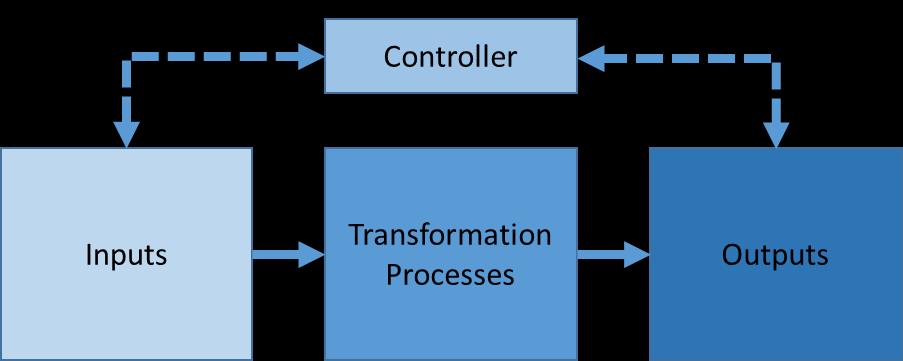
Military response?
Maintenance and Logistics leadership!
Figures 1 through 3 define the essence of operations management. Although they

provide little insight into military operations we nonetheless hypothesize that building a better
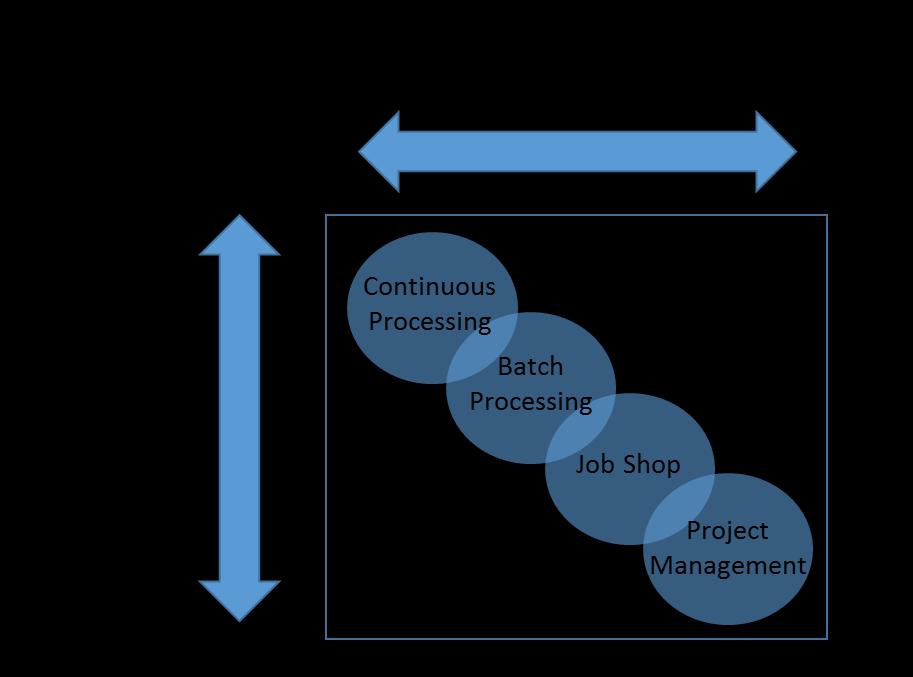
Operational resilience is ultimately the ability to succeed regardless of changing conditions such as garrison versus deployment and the leader must know what works best under each condition.
model of resilience begins with these constructs. For example, the influential work of Weick and Sutcliffe cite attention to operations as one of five practices central to successful crisis management. J. Meredith observes that the popularity of operations management moves counter to economic stability and prosperity in that operations management captures the most attention during turbulent periods and languishes otherwise. If that were the case in Air Force logistics we would focus on deployments but then fail to lead the routine, and/or fail to lead the transition between garrison and deployed operations. The converse could also be true: if logistics leaders focus on optimizing the routine we would then fail to prepare for deployments. Operational resilience is ultimately the ability to succeed regardless of changing conditions such as garrison versus deployment and the leader must know what works best under each condition.


Consistent with the IPO illustration we assume that any operation has a controller; the leader assigned the role of keeping the operation's activities aligned with its objectives. However, operational resilience cannot be fully related to operations management until the issue of that entity’s degree of control is recognized. We believe this control is the result of multiple factors, some of which are illustrated in Figure 4. As the divisions within this illustration suggest, these factors can be grouped into sets that reflect the original IPO model – input, process and output. For example, on the left side involving another organization in an operation is known to reduce the degree of control enjoyed by the leader. This powerful dynamic has motivated calls for better understanding of supply chain partnering and for reframing

procurement as a strategic issue. Furthermore, pursuing common goals bolsters control even as the growing complexity of global supply chain networks works against it. Moderating factors such as incentive schemes and greater investment in communication and coordination are characterized broadly as liaison devices supporting the control mechanism of mutual adjustment.
On the right side of Figure 4 a major factor in degree of control is the degree of customization of the deliverable. Product standardization, the opposite of customization, has long been recognized in organizational science as a powerful coordination mechanism that boosts control. In contrast, every military operation has a unique goal, and thus the complexity of customization is heightened, potentially compounded by the number of clients the operation is attempting to serve, and further complicated by time pressure and/or adverse environmental conditions for delivery of military logistics services.
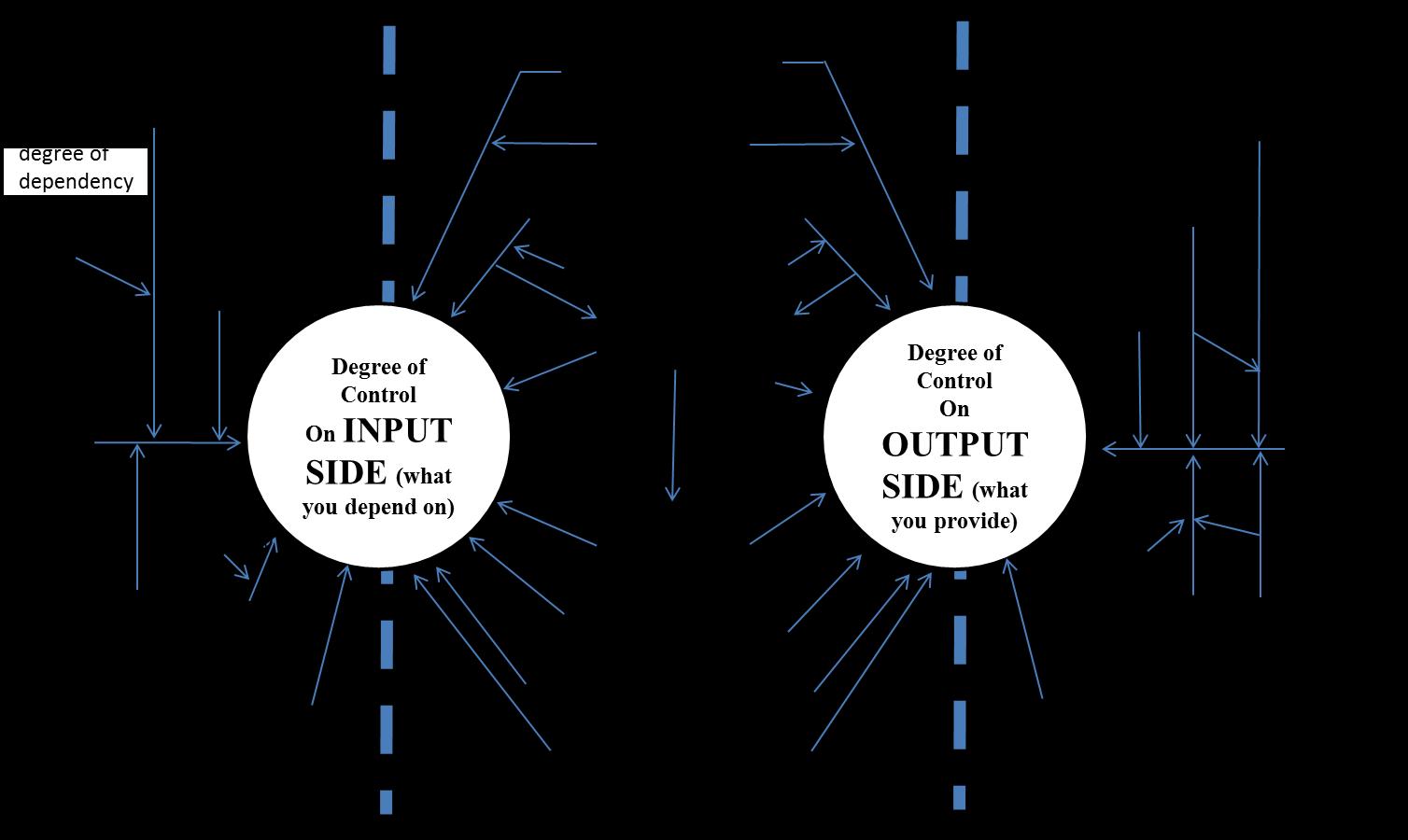
Contrasting the degree of control of the input-side versus the output-side of a given operation produces an alternate operations management taxonomy, appearing in Figure 5. We present these modes as a four-box model as this is the minimum level of complexity necessary to distinguish military operations from commercial businesses.



The goal of quickly and efficiently transitioning between modes – at the right time and place – would create what is defined here as operational resilience.
Despite a long history of managing operational modes, there remains little recognition of the fact that an operation need not be dedicated to a single mode only. As a result, there is even less understanding of how best to move between modes quickly, and the potential benefits of doing so appropriately. The goal of quickly and

efficiently transitioning between modes – at the right time and place – would create what is defined here as operational resilience.
In this study we explore the conceptualization of resilience as the ability to transition between known modalities through the study of two distinct organizations within the Air Force. First, Air Force Special Operations Command represents the potentially more resilient operation of flying and sustaining the CV-22 Osprey. Second, Air Combat Command provides contrast with the difficult task of sustaining its aging bomber, the B-1B Lancer. Although operational policies for both organizations are mandated through Air Force Instructions, each Command has evolved specific procedures and cultures to best suit their mission requirements. The project, started with differentiating elements in the weapons systems’ vulnerabilities, or potential for disruption, includes:
• Age of aircraft design and technology (Advantage: CV-22 Osprey. The CV-22 is the newer design first deployed in 2008, versus B-1B initial deployment in 1985; however, initial designs were from the 1970s.)
• Age of aircraft fleet (Advantage: CV-22 Osprey. The average age of the CV-22 fleet is 6 years, while the B-1B fleet averages 28 years.)
• Complexity of aircraft design (Advantage: B-1B Lancer. Even with the B-1B’s offensive and defensive systems and a swing-wing design, the highly complex CV-22 Osprey is capable of both horizontal and vertical flight, with all the associated vibration dynamics and stresses.)
• Environmental exposure (Advantage: B-1B Lancer. The B-1B operates exclusively from bases with improved runways, whereas the CV-22 may operate independent of landing facilities.)



To gather data on operational resilience, small group interviews were conducted on-site with key functional experts drawn from various areas – pilots, maintainers and logisticians – to gather data on their operational procedures. To facilitate this conversation, each group was asked to study the graphic in Figure 5, and confer on which modes describe their operation best at various times. Given that more than one mode was cited during discussion, participants were asked to identify which mode was their ‘normal’ or ‘default’ operation and what distinguished transition from one mode to another. Keeping with the systems perspective, participants were then asked to think of their operations in terms of its inputs and outputs. At this point, each member of the group was provided a paper copy of Figure 4, a graphic of common influences over the degree of control inherent in the governance of their inputs and outputs. Participants were first invited to delete or revise any portion of the diagram that was not applicable or varied from the perspective of their operation. Next, participants were asked to circle any element they felt was particularly important for effectively completing their mission. In all, six group interviews were conducted with a total of 28 individuals participating in this study.
To gather data on operational resilience, small group interviews were conducted on-site with key functional experts drawn from various areas – pilots, maintainers and logisticians – to gather data on their operational procedures.
To determine the important components of operational resilience, two methods were used to gain a broad understanding of the topics related to resilience: word clouds and pattern matching. Word clouds were created using the text from the CV-22 and B-1 focus groups. In particular, we used word clouds to quickly identify the most common words as a proxy for the most important topics in each group. The second method was pattern matching. This process groups common themes, and then assigns a relevance coefficient to a given input or output based on the responses from each subject, sorted by weapon system (see Figure 4). This data allowed the extraction of the most critical factors as related to operational resilience through a comparison of the two weapons systems. Although not necessarily generalizable beyond the weapon systems examined, the combined responses follow several patterns.
Resilience Enhancements
• Leadership centralization on-site
• Decentralized execution
• Use of informal agreements when formal policies become a hindrance
• Recognition and universal acceptance of common goals
• Increased communications
• Flexibility in operations
• Experience operating in various modes
• Lack of understanding of various modes of operations
• Lack of awareness of the current mode
• Limited risk taking
• Adherence to policies versus intent
• Sub-optimization of functional metrics versus enterprise-level objectives
• Increased number of outside parties you must deal with
The four modes were found to be distinct, requiring unique preparatory management and unique in-process management techniques to allow the timely and effective movement between modes. For the application of this sample within the Air Force, the taxonomy was adapted to represent the variety of mission requirements, as shown in Figure 6.
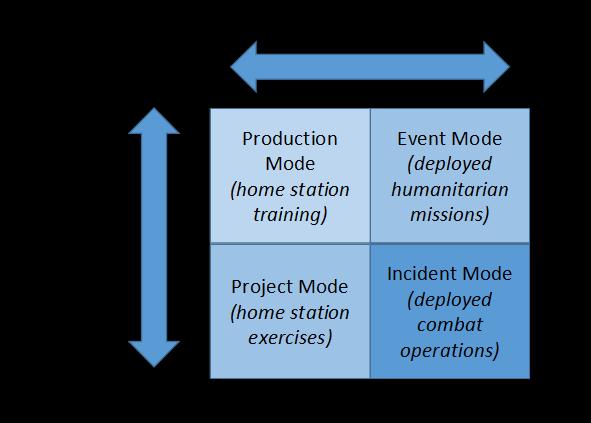
Results of this analysis validated the need to operate in various modes depending on the situation as defined by the level of control over inputs and outputs. Logistics leaders concerned with operational resilience should identify potential states as related to the modes of operation (Figure 5), then create organizational structures and internal policies to not only optimize each mode but also to expedite the transition between modes when necessary. For organizational structure a centralized control with decentralized execution was found to be more effective. For internal policies, a flexible set of guidelines combined with investment in advanced technical training and
education in operations



management will show resilience
Maintenance and logistics leaders must actively prepare for the change between operational modes, continuously sense and anticipate changes to other modes, and effectively manage in various modes at various times using a wide variety of skills to achieve their mission today and in the future – they must create operational resilience.
enhancements. As experience at the individual and organizational level was shown to be critical, units without recent experience in operating in each mode should focus future scheduled exercises with the intent of not only operating in an other-than-normal mode, but on the transition from day-to-day operations into that mode. Each exercise should be designed with the forethought of reinforcing operational changes required to first identify upcoming changes and then to move from Production to Project Mode, from Production to Event Mode, or from Production to Incident Mode. Throughout the analysis it was noted that increased communications via technological enhancements (handsfree radios, shared data, common
situational awareness using augmented reality, etc.) and strengthening of personal relationships –simple face-to-face interactions prior to events – will not only speed the transition of mode change but also make the new mode simultaneously more efficient and effective. Maintenance and logistics leaders must actively prepare for the change between operational modes, continuously sense and anticipate changes to other modes, and effectively manage in various modes at various times using a wide variety of skills to achieve their mission today and in the future – they must create operational resilience.
2LT Hayden Clark is the Assistant OIC, 909th Aircraft Maintenance Unit, 718th Aircraft Maintenance Squadron, Kadena AB, Japan
2LT Trevor Haydel is the Munitions Flight Commander, 9th Munitions Squadron, Beale AFB, CA
2LT Jordan Pierce is the Munitions Flight Commander, 23d Equipment Maintenance Squadron, Moody AFB, GA
Dr. Tim Pettit (Lt Col, USAF, Ret) served as the team mentor at the Air Force Academy’s Department of Management for this Capstone project. He served as an Aircraft Maintenance Officer and a Logistics Readiness Officer during his Air Force career. He now serves as Associate Professor and Lead Faculty for Supply Chain Management at National University, headquartered in San Diego, California, and continues to teach around the country, with special emphasis on military and veteran students.
Dr. Natalie Simpson is an Associate Professor and Management Undergraduate Program Chair of the Department of Operations Management and Strategy, University at Buffalo (SUNY), Buffalo, New York. Her textbook and classroom activities are used at the Air Force Academy’s Operations Management course, and her research interests include emergency response and incident management.
Dr. Philip Hancock has taught Operations Management, Service Management, Procurement and Disruption Management in both the US and the UK. He holds a PhD in Operations Research and has spent over 20 years in industry. He has Institute for Supply Management accreditation as a Certified Professional in Supply Management (CPSM) and Supplier Diversity (CPSD).
 By: Mr. Ronald Thompson
By: Mr. Ronald Thompson

Throughout our military careers we are bombarded with different leadership styles. We studied as well as heard from some of the leaders on the development and training they received to lead. We went to schools and studied: the Art of War, Fog of War, and many others. We read books on: Sun Tzu, Patton, Schwarzkopf, Creech, Arnold, Babbitt and others successful leaders. We had leaders come and talk to us about their leadership styles. Collectively, all of the messages lead to one simple lesson: to lead you need to get out from behind your desk and see what your people are doing! In my case, getting out and walking the flight line, going through the phase docks, wash rack and maintenance facilities, helped me get a feel for what was happening in the Squadron and the Wing, The purpose was to motivate people to do the right things use proper technical data, keep the work environment good and clean, and ensure quality customer service. Be out-front leading the way. This is and always will be the way I wanted to lead. It was great getting out seeing what was going on! Fortunately or unfortunately, our daily work route changed with the introduction of the computer.

When the computer entered the scene it was great, time saving, yet confusing. A limited amount of people knew how computers operated. A program like email was fascinating! It was a great way to get word to selective people in an organization without verbally communicating with them talking to them. It was a neat, elitist way to pass information quickly to get things accomplished. For those of us remembering those days, recall the first letter you went to print and when it didn’t work the gyrations we went through to rectify the problem; it was just a learning curve issue. However, there were unexpected side effects occurring right before our eyes; items such as; dissolving of the chain of command due to direct access to people. All in all, it was frustrating, yet crazy and fun to be on the leading edge of technology. In this environment you still didn't have a problem getting out seeing your people and the quality of work going on within your organization. As for those classes, theories and philosophies the computer started diluting them, because, like everything else the computer got more efficient. With efficiency came more reliability and dependency on computer driven communications. Within a short period of time, leaders found themselves more and more strapped to the office, basically to answer email taskers (No more blue slips or snowflakes). The result of this efficiency was more time on the computer and less time out and about! When something happened, in the work area, either good or bad you could usually be found pecking away on the computer for some "I have to know, right now!" answer, usually taskers that did not
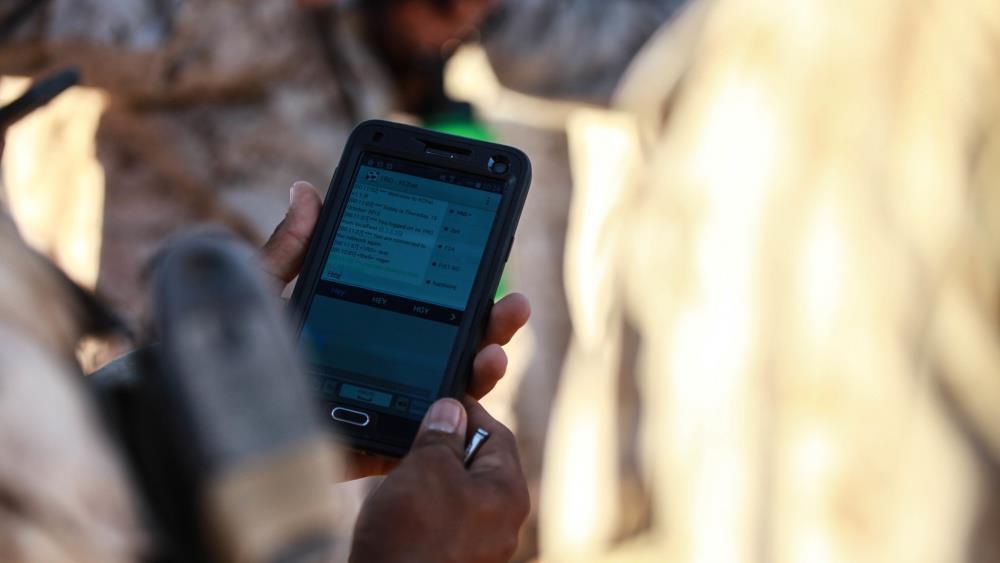
live up to the hysteria of the senders. But, you still could get out and see your people, albeit a much shorter time. Then leaders were introduced to the "Blackberry"! This little piece of electronics has and is causing a bigger setback in leadership than most any other piece of equipment.
The Blackberry has made it possible for supposed leaders to hide in their own little world somewhat oblivious to the people they are supposed to be leading. Basically, it is the new micromanagement tool for people afraid to shake hands, look someone in the eye and talk to them! It ends up as, basically the only communication you get is a blackberry message that; may have a need to be answered right away or just a message to show subordinates you have the thing! In fact we have become obsessive compulsive about using the device. One of the best examples I have heard was; two Colonels and a Lieutenant Colonel where sitting in an airport, waiting for a flight. As the Lieutenant Colonel was sitting between the two Colonels, there was a little conversation, but the majority of the times the Colonels were deeply involved with the use of their Blackberries, answering who knows what. The Lieutenant Colonel didn't think too much about it until returning to his office and finding his computer loaded with emails from the two Colonels, during the exact time they were in the airport! What’s worse, they were asking questions they could have asked and had answered by him while in the airport, amazing isn't it!
It is now plausible to say leaders can spend basically a tour at a location and never really meeting their subordinates. This could drive some real changes as; renaming the change of command ceremony to “Change of Blackberries”, reducing the ceremony to a few minutes with an “address to all” used for speeches….etc!
Electronic communications are good and necessary. But in a leadership role you are still responsible for getting out seeing their people. It is a leader’s responsibility to go out and glean information for them self! Without physically getting out and staying in an obscure role, you only see the people you want to see. Do you know who your real silent giants are? How about the people making it happen and don't expect or want recognition? Do you know who your blabber mouth non-producers are, or do you rely on someone to tell you who your good and bad performers are? Do you go see why or how directives are being accomplished or do you wait for an inspection team to tell you? All the leaders, I have worked with, were visible in every aspect, even when you didn’t want them there. They were doing their part of knowing their Command. They made time to get out from behind their desk meet the people. They knew the organization. They were out-front leading the way; looking at you right in eye, not hiding in an office sending out emails. Physically meet your people in their work place, let them know you are interested in what they are doing! Looking for improvements, listen, ask for suggestions, and intercept problems before they occur or get bigger. Many things will change albeit for the good or bad, but one action of getting up and going out and meeting your people worked before and it still works now! So, leave the electronic devices behind and venture out and see what’s going on!
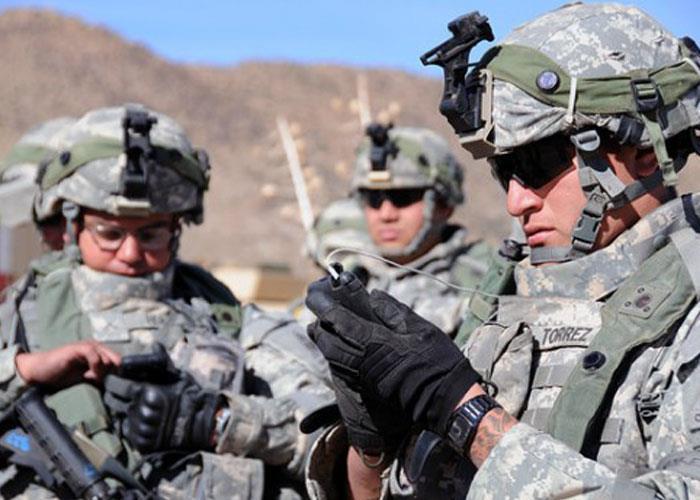

 By: Captain Robbie Walsh
By: Captain Robbie Walsh
EProcess excellence, the cornerstone of any successful unit, is currently being employed within the Defense Logistics Agency at Oklahoma City. In order to achieve strategic goals centered on lean methodologies, 24 leaders from seven different locations throughout the Defense Logistics Agency (DLA) met for a two-day seminar on 9-10 September designed to introduce students to a common understanding of the Air Force Sustainment Center (AFSC) Art of the Possible methodology. This is a powerful set of tools used in the development of enterprise ‘Road to…’ goals, which provides a clear sight picture to measure process execution. During this seminar, the DLA team successfully learned process excellence from subject matter experts who use it every day within the AFSC.
Kicking the event off, students were introduced to AFSC Way concepts where briefers focused on the value of speed through increased throughput and reduced Work in Progress (WIP). Briefers homed in on the fundamental principles of Little’s Law, the Gated Monitoring System, Theory of Constraints and the value of Drum-Buffer-Rope principals originally introduced by Eliyahu M. Goldratt in his 1984 book titled The Goal.
The Art of the Possible Course also marked the first time leaders from DLA have been introduced to the AFSC Leadership Model, the cornerstone of process excellence. According to the Art of the Possible, “the leadership model provides enduring principles to equip leaders with
a holistic approach to gaining effectiveness and efficiency.” Coupled with a standardized Continuous Process Improvement (CPI) methodology, the model focuses on uniting people, processes, and resources around a common goal to achieve maximum efficiency and weapon system readiness, ultimately leading to the generation of airpower for America.
Students were introduced to the inner workings of the Production Machine, a methodical approach to business and the science behind production. Subject matter experts assigned to the Oklahoma CityAir Logistic Complex successfully defined critical path and described the use of ‘queue’ within the production machine. Students were also introduced to the effective use of ‘Takt Time’ the average time between the start of production of one unit and the start of production of the next unit as it relates to customer demand.
Next, students listened to AFSC transformation specialists certified as LEAN/Six Sigma Black Belts who centered on the many facets of CPI. Focusing on LEAN practices, students learned that with consistent implementation of the five principles below, it is possible to create a ‘new norm’ within their specific organization:
Identifying Value: By identifying all of our customers and clearly defining value from the warfighter’s perspective, all non-value tasks can be identified as waste
Value Stream: The entire set of tasks throughout the organization jointly involved in providing a product, or a service, to the Warfighter
Creating Flow: Elimination of non-value added waste ensures that products or services flow to the customer with increased speed and quality
Pull: Creating an operation flexible enough to support day-to-operations by understanding the customer’s demands and fulfilling the Warfighter’s requirement when and where they need it
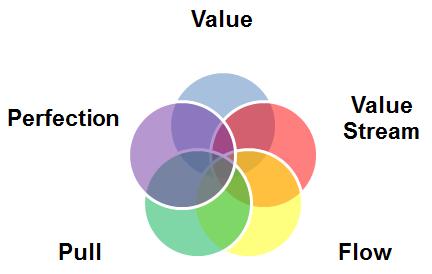
The Pursuit of Perfection: Finding the harmony between the creation of flow and the action of pull, whereby we produce to fulfill the need without creating additional waste
DLA Art of the Possible Course Attendees wrapped up a packed first day with a tour of the 564th Aircraft Maintenance Squadron which included the ‘KC-135 Depot Maintenance Road To…’ briefing and Squadron Walk-the Wall.
Day 2 of the event kicked off with a brief centered on the AFSC Radiator Chart.
Focusing on establishing ‘Road To ’ goals, students were led through a series of case studies centering on the following areas of management: networks, gates, release points, visual displays, scripting, tools, tech data and most importantly, production touch time. By employing levers (outlined in green), students were taught how to effectively drive positive change and fuel production execution, both on and off the shop floor.
Next, students were briefed by members of the AFSC Financial Management Office on the intricacies of the Air Force Working Capital Fund (AFWCF). Vital to readiness, and the sustainability of air and space assets, the AFWCF provides the financial means for maintenance services and weapon system support. The fund provides critical support to maintenance depots for specialized equipment, skills, and repair services necessary to keep forces operating worldwide, specifically through the use of Supply Management Activity Group-Retail funds (SMAG-R) and Consolidated Sustainment Activity Group funds for both supply operations and maintenance (CSAG-M and CSAG-R).
Students were also given briefings from the AFSC Logistics Directorate centered on the implementation of a comprehensive performance management program where briefers introduced the class to the Weapons Systems Enterprise Review, performance review primers, and achieving strategic goals. Guided through a capstone coined ‘Connecting the Dots’, briefers were able to drive home that Art of the Possible implementation and success is contingent upon networking, high confidence planning, standard work scripting and efficient battle rhythms.

The class also had the wonderful opportunity to soak in briefings given by the 635th Supply Chain Operations Wing Commander, Col Linda Hurry, and the 448th Supply Chain Management Wing Director, Mr. Frank Washburn. As both organizations are critical to Air Force Supply Chain, Mr. Washburn touched on operationalizing the 448th Supply Chain Management Wing through cost effectiveness, efficient sourcing, and mission readiness. Colonel Hurry focused on the many facets of retail supply chain centralization and the future of 635th Supply Chain Operations Wing. The class finished up the last day with a tour of the 423d Supply Chain Management Squadron, where members of the unit stepped the class through a supply chain management ‘Walk-the-Wall’ session and were also given the units battle rhythm briefing.
So what’s next? How does DLA Aviation plan to use the information contained within the Art of the Possible Course to better assist the organization as a whole?
Brigadier General Allen Day, DLA Aviation Commander states, "Achieving process excellence is one of my top priorities for DLA Aviation. Committing my senior DLA Aviation leadership team to partner with our AF customer to take this course achieved two goals. First, we quickly improved our understanding of how AFSC does business and what drives their depot processes resulting in a closer alignment of our support efforts. Second, we are leveraging the AFSC Art of the Possible approach to further develop our own culture of process excellence."
DLA’s vision involves a CPI-driven culture focused on wholesale and retail excellence that is able to respond to the needs of the Warfighter with flexibility, speed, and quality. Overarching goals of this new initiative, coined ‘Aviation Process Excellence’ includes:
Educating the work force in process excellence tools, LEAN concepts and problem solving models so that leaders and supervisors throughout the organization are better equipped to drive positive change while tackling constraints, not personnel
Building workforce CPI skillsets through on-the-job training, LEAN/Six Sigma workshops, and Art of the Possible Course refreshers
Utilizing the Art of the Possible Leadership Model and Walk-the-Wall to maximize communication and drive positive change at all levels
Enhancing the Air Logistics Center’s ability to meet their objective by amplifying a goal of Zero Line Stops and Zero Workarounds
Improving flow time of Purchase Requests, Order Response Time, and Backorder mitigation through teamwork and collaboration
Through the establishment of common goals, leaders from within DLA Aviation Oklahoma City have developed a training plan and a series of milestones to ensure Process Excellence Initial Operational Capability (IOC) for the organization. Those milestones include: establishing directorate cross talks, identifying line of effort team leads, and process excellence rollout plan broken into three distinct training phases:
Phase 1: The establishment of a train-the-trainer course taught by the DLA Aviation Academy
Phase 2: Process Excellence training for all employees and supervision at each ISA
Phase 3: The establishment of a bi-annual DLA Senior Leadership Course for branch chiefs and key personnel designed to amplify process excellence and Art of the Possible principles
Although the overall effort is still in its beginning stages, students from the first DLA Art of the Possible seminar came away with a new appreciation for process excellence and the critical part that the Art of the Possible has played in driving change across the AFSC. With sweeping popularity, students of the 2-day seminar provided overwhelmingly positive feedback, ensuring that lessons learned in the course would soon be implemented within their respective organizations. It is with high hopes that the leadership lessons and management concepts contained within the Art of the Possible will continue to help strengthen a universal language of process excellence, building on positive transformation and process improvement for both organizations in the future.

Capt Robbie Walsh is currently a Logistics Career Broadening Officer at Tinker AFB, OK. During this assignment he has had rotations in the 448th Supply Chain Management Wing, B-1/B-52 System Program Office, Defense Logistics Agency Aviation, and currently B-52 Programmed Depot Maintenance Capt Walsh is a career Logistics Readiness Officer and has served in LRS Fuels Flight, Deployment and Distribution, Vehicle Management, and Director of Operations. His duty stations include Pope AFB, Kunsan AB, and Tinker AFB, OK


In late February 2016, the Logistics Officer’s Association, Razorback Chapter, attended a tour of the F-35 Production Plant at Lockheed Martin Aeronautics Company in Fort Worth, Texas. While there, Mr. Gene White and his team of experts briefed, in detail, the functions and features of the three aircraft models, A, B, and C and who will be receiving them in the future.
The tour began with an overview of the F-35 program, including a brief by the F-35 Sustainment Manager, a retired Air Force Colonel who served as an Aircraft Maintenance Officer. Her briefing opened the eyes of the officers who attended the tour to the vastness of the F-35
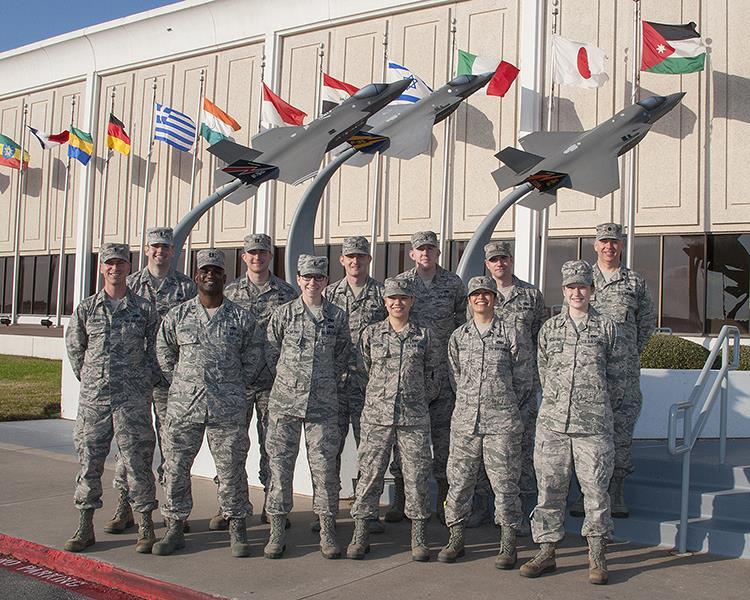
program. She discussed the design challenge Lockheed Martin underwent as they developed three variations of the aircraft with distinct capabilities and yet a remarkable amount of overlap between the variants. Beyond the technical design of the aircraft itself, the program’s development also required extensive planning to account for maintainer and operator training requirements, ground servicing equipment, tools, test equipment, technical data management, command and control, maintenance information systems, and basing strategy. Not only did these processes have to be developed, but they have to be sustained through the life of the weapon system. It was fascinating to see the complexity of the overall program and gain an appreciation for the amount of care taken to keep the program moving forward.
It was reassuring to see that all the data maintenance spends so much time documenting is actually used to develop solutions to the problems we face in the field.



Next, Mr. White took the members through the production line and explained the entire process in developing and procuring an F-35, from start to finish. As
the aircraft begins to take shape through the production line, a sign hangs over each work station it visits, letting all the workers know the owning country and the gaining unit for each serial number in production. It was astonishing to learn that the procurement lead time for some of the components on the aircraft was five years. Throughout the plant, precision shown through every aspect of production, from the treatment process used to create the low-observable exoskeleton to the jigs crafted to drill thousands of holes in each wing section.
To close out the day, the tour visited an F-35 simulator, the operations center, and a LEAN office in the plant. The simulator helped develop everyone’s appreciation for the capabilities of this fifth-generation fighter. Both the operations center and the LEAN office reiterated the level of dedicated support Lockheed offers to units already flying the F-35. In the LEAN office, a team
of analysts delved into dozens of fleet health indicators, seeking out problem areas that might warrant a re-design, a new source of supply, or a re-write of technical data. It was reassuring to see that all the data maintenance spends so much time documenting is actually used to develop solutions to the problems we face in the field. Seeing the field’s data up on the screen also reinforced the importance of Data Integrity!
Even though the tour took less than a full day, each of the officers in attendance gained a valuable appreciation for aircraft program management in general and the F-35 program specifically. If you have a chance to visit a production line, do it. As a field-level logistician, there is no substitute for seeing the processes and meeting the people who work so hard to keep the US flying.
